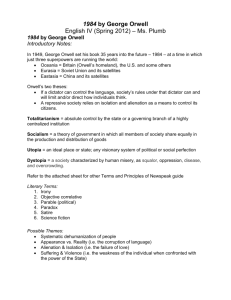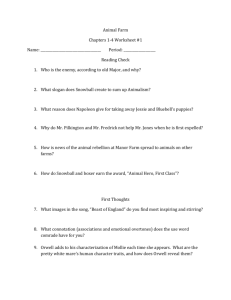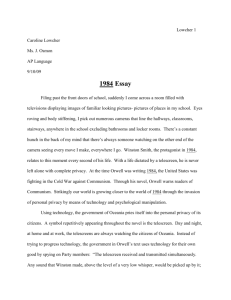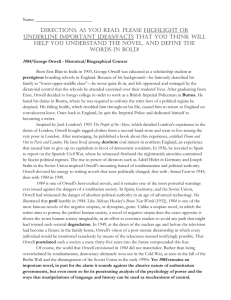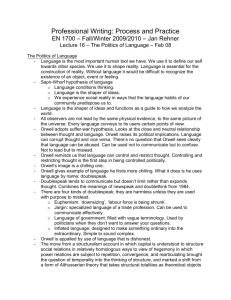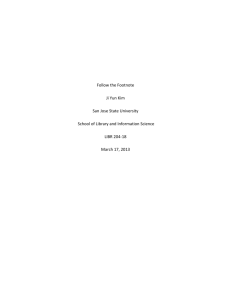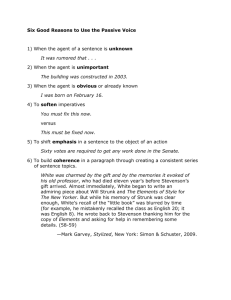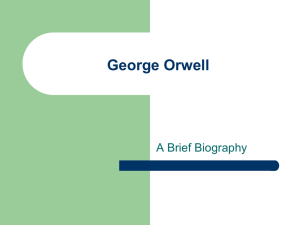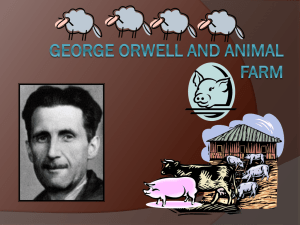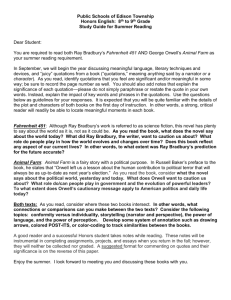1984 HISTORICAL BACKGROUND - Fall River Public Schools
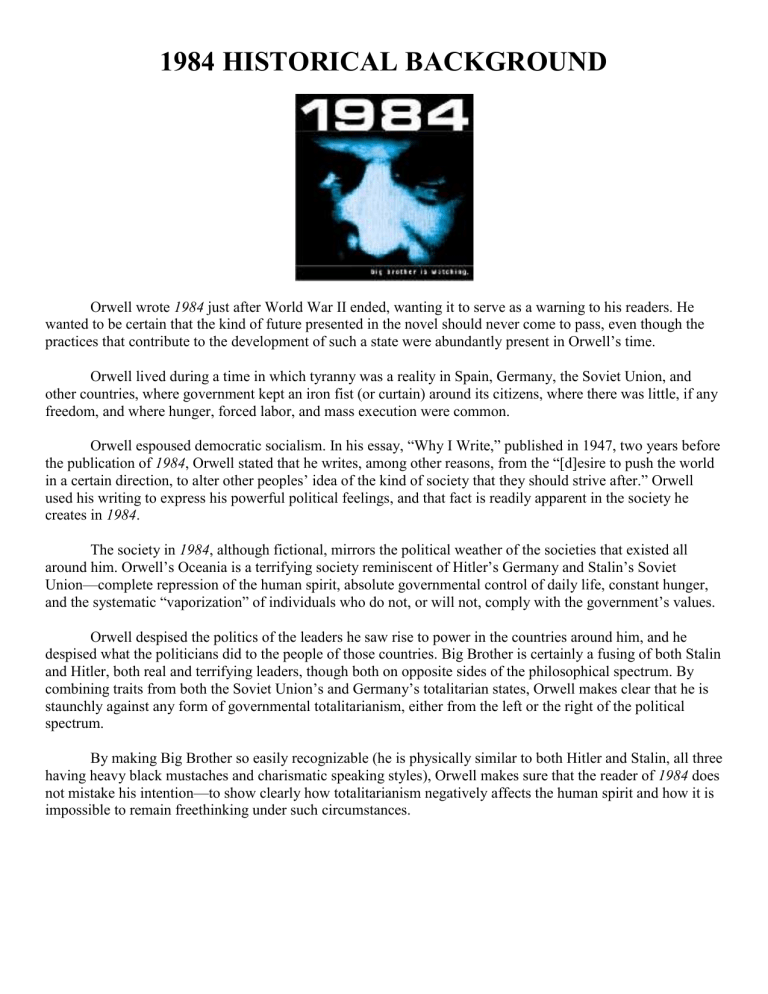
1984 HISTORICAL BACKGROUND
Orwell wrote 1984 just after World War II ended, wanting it to serve as a warning to his readers. He wanted to be certain that the kind of future presented in the novel should never come to pass, even though the practices that contribute to the development of such a state were abundantly present in Orwell’s time.
Orwell lived during a time in which tyranny was a reality in Spain, Germany, the Soviet Union, and other countries, where government kept an iron fist (or curtain) around its citizens, where there was little, if any freedom, and where hunger, forced labor, and mass execution were common.
Orwell espoused democratic socialism. In his essay, “Why I Write,” published in 1947, two years before the publication of 1984 , Orwell stated that he writes, among other reasons, from the “[d]esire to push the world in a certain direction, to alter other peoples’ idea of the kind of society that they should strive after.” Orwell used his writing to express his powerful political feelings, and that fact is readily apparent in the society he creates in 1984 .
The society in 1984 , although fictional, mirrors the political weather of the societies that existed all around him. Orwell’s Oceania is a terrifying society reminiscent of Hitler’s Germany and Stalin’s Soviet
Union—complete repression of the human spirit, absolute governmental control of daily life, constant hunger, and the systematic “vaporization” of individuals who do not, or will not, comply with the government’s values.
Orwell despised the politics of the leaders he saw rise to power in the countries around him, and he despised what the politicians did to the people of those countries. Big Brother is certainly a fusing of both Stalin and Hitler, both real and terrifying leaders, though both on opposite sides of the philosophical spectrum. By combining traits from both the Soviet Union’s and Germany’s totalitarian states, Orwell makes clear that he is staunchly against any form of governmental totalitarianism, either from the left or the right of the political spectrum.
By making Big Brother so easily recognizable (he is physically similar to both Hitler and Stalin, all three having heavy black mustaches and charismatic speaking styles), Orwell makes sure that the reader of 1984 does not mistake his intention—to show clearly how totalitarianism negatively affects the human spirit and how it is impossible to remain freethinking under such circumstances.
1984 STORY SETTING AND BACKGROUND
The setting of 1984 is Oceania, a giant country comprised of the Americas; the Atlantic Islands, including the British Isles; Australia; and the southern portion of Africa. Oceania’s mainland is called Air Strip
One, formerly England. The story itself takes place in London in the year 1984, a terrifying place and time where the human spirit and freedom are all but crushed. In the novel, war is constant. The main character,
Winston Smith, born before the World War II, grew up knowing only hunger and political instability, and many of the things that he experiences are hyperboles of real activities in wartime Germany and the Soviet Union.
It is important to remember that Orwell based 1984 on the facts as he knew them; hunger, shortages, and repression actually happened as a result of the extreme governmental policies of these countries. The war hysteria, the destruction of the family unit, the persecution of “free thinkers” or those who were “different” or not easily assimilated into the party doctrine, the changing of history to suit the party’s agenda, were all too real.
Orwell’s speculation of the future is actually a creative extension of how the masses were treated under Franco,
Hitler, and Stalin.
By setting 1984 in London, Orwell is able to invoke the atmosphere of a real war-torn community, where people live in “wooden dwellings like chicken houses” in bombed-out clearings. His intent clearly was to capitalize on a memory that every reader, especially a British reader, was likely to have. London in 1984, then, becomes not just a make-believe place where bad things happen to unknown people, but a very real geographical spot that still holds some connection for the modern reader.
In 1984, the world is sliced into three political realms—the super states of Oceania, Eastasia, and
Eurasia. Orwell drew these lines fairly consistent with the political distribution of the Cold War era beginning after World War II. Each of these three states is run by a totalitarian government that is constantly warring on multiple fronts. By creating an entire world at war, Orwell not only creates a terrifying place, but he also eliminates the possibility of escape for Winston, who is forced to live within his present circumstances, horrible and unremitting as they are.
Oceania’s political structure is divided into three segments: the Inner Party, the ultimate ruling class, consisting of less than 2 percent of the population; the Outer Party, the educated workers, numbering around 18 to 19 percent of the population; and the Proles, or the proletariat, the working class. Although the Party (Inner and Outer) does not see these divisions as true “classes,” it is clear that Orwell wants the reader to see the class distinctions. For a socialist such as Orwell, class distinctions mean the existence of conflict and class struggle.
In Hitler’s Germany and Stalin’s Soviet Union, for example, the few people who comprised the ruling class had a much higher standard of living than the masses, but in these nations, as in 1984 , revolt was all but impossible.

